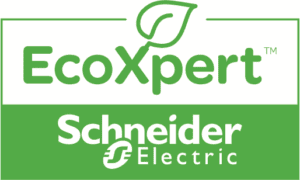Changes to a building that occur over time can often make building performance less efficient and less resilient. As time goes on, building use characteristics often diverge from those that were used initially to design and commission a building. A good example of this is improper outside air ventilation rates which can lead to problems with indoor air quality (IAQ), or excess operational costs. Building power and cooling infrastructure components can also wear out and fall out of calibration. As more and more powered equipment gets added, power capacities are exceeded, and unanticipated downtime issues begin to emerge.
As systems age, they decline in performance, which leads to failures that significantly impact the bottom line. We partner with our customers to implement solutions that keep systems operational by thinking strategically about proactive measures and how those actions impact the business over time.
At Stark Tech Group, we work as a Schneider Electric EcoXpert™ Partner with expertise in their EcoStruxure™ Building architecture and building automation. Our engineers encounter many situations where building owners need help improving existing building performance.
A perfect example is a research facility that examines proteins and crystals in their research of bacteria and virus-borne diseases. The facility recently decided to upgrade its installed base of microscopes in response to pharmaceutical customer demand for more accuracy. Their existing building power infrastructure supported a 1-megawatt (MW) power switch, which was previously adequate as the building consumed 600 kW of power on an average day, and nosed up to 800 KW on the hottest of summer days when air conditioning systems work at full capacity.
Given the required upgrade, a cost effective, steady power supply with peaks in excess of 1MW was now required in order to accommodate stringent purity requirements and to avoid losing both data and research samples.
Our solution was to implement a lithium-ion-based energy storage solution physically located inside of the building. The battery selected for this purpose supplies stored power to the facility when demand spikes over 1MW and then recharges from the grid. This cost-effective change to the lab’s existing power infrastructure successfully managed the building’s increased power capacity requirements and helped the research lab remain competitive in their market.
Approaches for validating current building requirements
For organizations seeking to ensure consistent building power, cooling, and building automation performance, here are some preliminary steps that should be taken to validate requirements:
- Identify common needs of both traditional and new critical infrastructure – Building owners need to periodically assess the health of different types of building critical infrastructure. This includes both generators and power distribution systems and the IT backbone – anything that keeps the building on its mission at a predictable operating cost. These infrastructure pillars need to be assessed in order to determine whether changes to the building have altered the efficiencies.
- Identify needs unique to your facility – Understanding the unique requirements of the building under management also heavily impacts how technology is deployed to improve performance. Sports arenas, for instance, have a specialized need for higher dehumidification. High precision temperature control and monitoring are needed to both accommodate tens of thousands of fans and to assure that ice rink temperatures, for example, are properly maintained.
Healthcare facilities require more highly regulated environments. Circulating air has to be regularly monitored. Sophisticated backup power systems are required since connected hospitals have no real ability to shut down. In government and municipal buildings–such as prisons and K-12 public schools–a higher focus on safety and security emerges as a primary concern. Commercial buildings are focused more on comfort and lighting so that employee productivity can be maintained. Knowing the unique characteristics of your building and applying the right building automation technologies suited to those unique needs is a key performance driver.
Changing times demand more building resilience
Regardless of the type of facility, building owners also need to be aware that building resilience is emerging as a growing need. For many years, predictable building performance was taken for granted by the occupants. But now, the existing power grid has grown older. As power sources such as coal and nuclear phase out in the US, new solar and wind power are being introduced. These changes make power quality more intermittent and downtime can now occur in areas where power fluctuations were once rare. In addition, pockets of businesses continue to expand across regions driving more demand for clean, “always on” power. In these cases, building infrastructures need to be reexamined in order to withstand the demands of the “new normal.”
To learn more about how digitized building automation solutions can improve building performance, visit the Schneider Electric EcoStruxure for Buildings web site.
EcoXpert™ partners – the implementation arms of EcoStruxure™
The EcoXpert Partner Program is unique in its industry and made up of a best-in-class global ecosystem of expertise. Trained and certified by Schneider Electric, EcoXperts are the implementation arms of EcoStruxure in homes and buildings all over the world.
Schneider Electric’s EcoXpert Partner Program unites the world’s leading technology providers, who exhibit best-in-class system integration competencies in facility optimization, reliable infrastructures and energy management, with its customers around the globe. Stronger together, this partnership cultivates collaboration, connects expertise, and delivers best-in-class services and solutions.
Visit EcoXpert to learn more.




